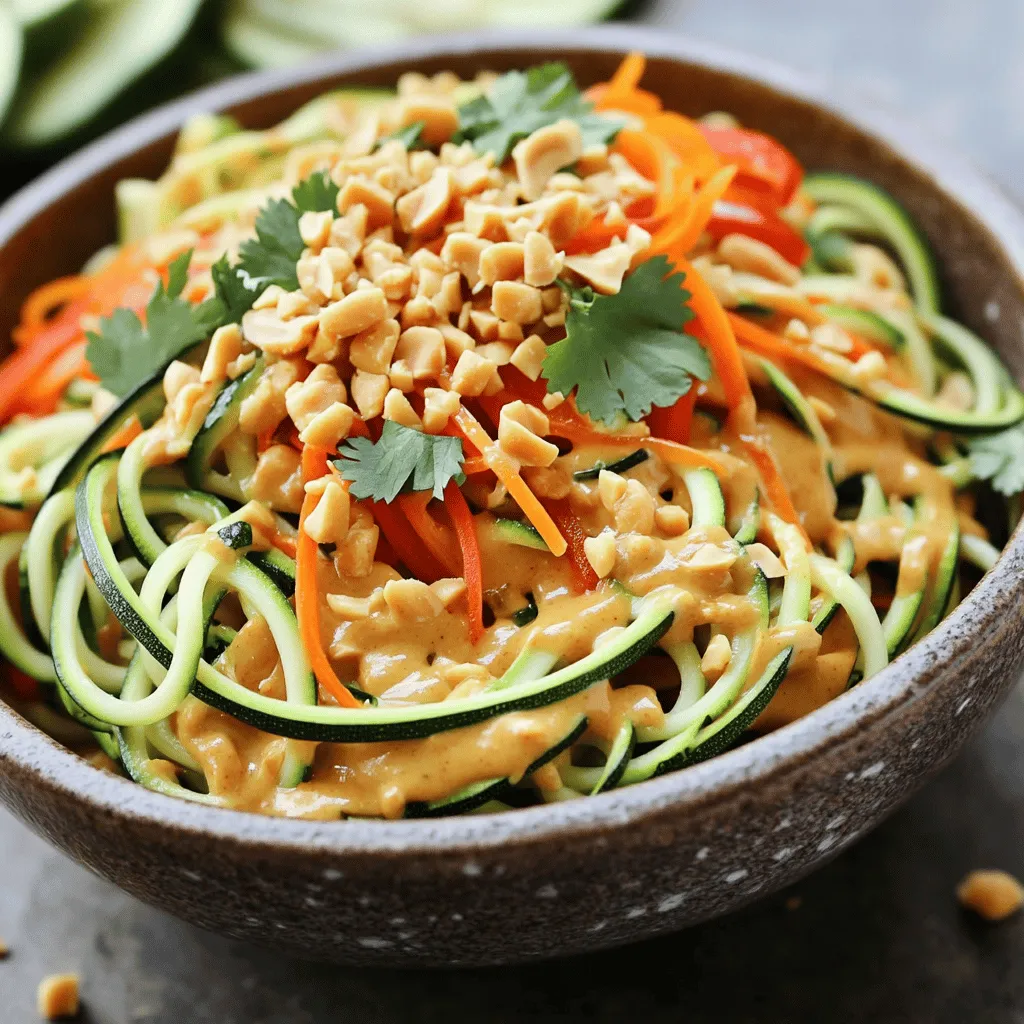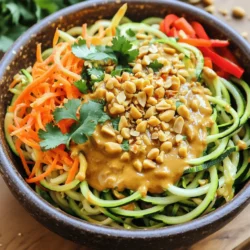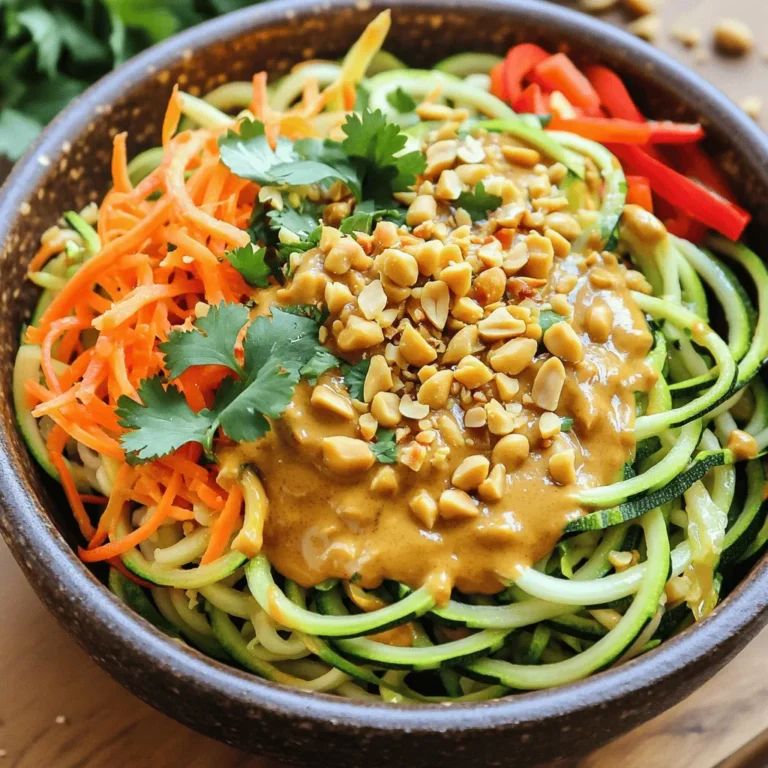Looking for a fresh twist on a classic dish? My Zucchini Noodle Pad Thai is both tasty and easy to make! In this recipe, I swap traditional noodles for vibrant zucchini noodles. You’ll enjoy a healthy meal packed with flavor, ideal for any occasion. Follow my simple steps, tips, and variations to create a dish that suits your tastes. Let’s dive into this fun and nutritious recipe!
Ingredients
List of Main Ingredients
For a tasty Zucchini Noodle Pad Thai, you need the right ingredients. Here’s what you’ll use:
– 4 medium zucchinis, spiralized into noodles
– 1 cup fresh bean sprouts
– 1 cup shredded carrots
– 1 red bell pepper, thinly sliced into strips
– 3 green onions, chopped finely
– 2 cloves garlic, minced
– 1 tablespoon fresh ginger, grated
– 3 tablespoons creamy peanut butter (or almond butter for a nuttier flavor)
– 2 tablespoons soy sauce (or tamari for a gluten-free option)
– 2 tablespoons fresh lime juice
– 1 tablespoon fragrant sesame oil
– 1 teaspoon chili paste (adjust according to your spice preference)
– 1/4 cup roasted peanuts, roughly chopped for garnish
– Fresh cilantro leaves for garnish
These ingredients create a bright and fresh dish. The zucchini noodles replace traditional rice noodles, making it light and healthy. The crunchy veggies add color and texture. The peanut butter and soy sauce blend for a creamy, savory sauce. Each bite bursts with flavor, and the garnishes take it to the next level.
Step-by-Step Instructions
Preparation and Cooking
Spiralizing the zucchinis
First, grab your spiralizer or a vegetable peeler. Take the zucchinis and turn them into noodle-like strands. This step is fun and easy. Place the spiralized zucchini in a bowl and set it aside for later.
Sautéing the aromatics and vegetables
Next, heat your skillet or wok over medium-high heat. Add the sesame oil. Once it’s hot, toss in the minced garlic and grated ginger. Sauté these for about 30 seconds. You want to smell those wonderful aromas! Then, add the sliced red bell pepper and shredded carrots. Cook them for 2-3 minutes. They should soften but still have a nice crunch.
Combining with sauce and serving
Now it’s time for the star of the show: the zucchini noodles. Gently add them to the skillet. Cook for another 2-3 minutes, stirring gently. You want to keep them firm. In a separate bowl, whisk together the peanut butter, soy sauce, lime juice, and chili paste. Pour this sauce over the veggies and noodles in the skillet. Stir well to coat everything evenly. Finally, add the fresh bean sprouts and chopped green onions. Toss everything together until heated through. Serve your dish hot, topped with chopped roasted peanuts and fresh cilantro leaves.Enjoy your colorful and tasty Zucchini Noodle Pad Thai!
Tips & Tricks
Cooking Tips for Best Results
Maintaining the texture of zucchini noodles
To keep zucchini noodles firm, avoid cooking them too long. Sauté them just until they warm. This keeps them crunchy and tasty. If you want more texture, you can briefly salt the noodles before cooking. This draws out some moisture.
Adjusting spice levels
If you love spice, add more chili paste. Start with one teaspoon, and taste as you go. You can always add more but can’t take it out once mixed. For a milder dish, reduce the chili paste. You can also use sweet chili sauce for a sweet twist.
Importance of fresh ingredients
Using fresh veggies makes a big difference. Crisp bell peppers and vibrant green onions boost flavor and color. Fresh lime juice adds brightness, while garlic and ginger give depth. Always choose the best ingredients you can find. This will lift your dish and impress your guests.

Variations
Dietary Adaptations
You can easily change this Zucchini Noodle Pad Thai to fit your diet.
– Vegan substitutions: To make this dish vegan, use plant-based peanut butter and tamari. This keeps the creamy texture and flavor without animal products.
– Gluten-free options: If you need gluten-free, swap soy sauce for tamari. It tastes great and keeps your dish safe for those with gluten issues.
– Adding protein sources: If you want more protein, add tofu, chickpeas, or cooked chicken. Tofu is a great vegan option. Just sauté it until golden brown before mixing it with the other veggies.
These adaptations make this dish flexible. You can enjoy it no matter your dietary needs.
Storage Info
Storing Leftovers
To keep your Zucchini Noodle Pad Thai fresh, store leftovers in an airtight container. Place the container in the fridge. This dish stays good for 2-3 days if stored properly.
When you’re ready to eat, reheating is key. Use a skillet over low heat. Add a splash of water to help steam the noodles. This method keeps them from turning mushy. Stir gently as they warm up to maintain their texture.
If you have extra sauce, heat it up separately. This way, you can add it for extra flavor when serving. Enjoy your delicious leftovers just like the first time!
FAQs
Common Questions about Zucchini Noodle Pad Thai
Can I make this dish ahead of time?
Yes, you can prepare some parts in advance. Spiralize the zucchinis and chop the veggies ahead of time. Store them in the fridge. This makes cooking quick and easy. However, I suggest making the sauce fresh for the best flavor.
How do I store zucchini noodles?
Store zucchini noodles in an airtight container. Place a paper towel in the container to absorb excess moisture. This keeps them fresh for about 2-3 days. Avoid freezing them, as it changes the texture.
What can I use instead of peanut butter?
If you need a swap, try almond butter. It adds a nice nutty taste. Sunflower seed butter also works well for a nut-free option. Each choice gives a unique flavor, so feel free to experiment.We covered the main ingredients, including the fresh veggies and sauces. The step-by-step guide made cooking easy. Tips helped maintain the perfect texture. We discussed dietary options for everyone, plus ways to store and reheat leftovers.
Overall, making this dish is simple and fun. With these ideas, you can enjoy a healthy twist on a classic favorite. Dive into your kitchen and give it a try!


